AKTIVITAS ANTIMIKROBA EKSTRAK ETANOL BATANG WOLE WOE ASAL HALMAHERA TENGAH TERHADAP BAKTERI GRAM POSITIF Staphylococcus epidermidis DAN Staphylococcus aureus
Abstract
Keywords
Full Text:
PDF (Bahasa Indonesia)References
Dwijendra IM, Wewengkang DS, Wehantou F. Aktivitas Antibakteri dan Karakterisasi Senyawa Fraksi Spons Lamellodysidea Herbacea yang Diperoleh Dari Teluk Manado. PHARMACON Jurnal Ilmiah Farmasi . 2014; 3(4):1–10
Juariah S, Suryanto D, Jamilah I. Aktifitas Anti Bakteri Spesies Asterias Forbesii Terhadap Beberapa Jenis Bakteri Patogen. Berkala Perikanan Terubuk. 2014; 42(2):37–50
Permata Dewi A, Fauzana A. Uji Aktivitas Antibakteri Ekstrak Etanol Biji Mahoni (Swietenia mahagoni) Terhadap Shigella dysenteriae. JOPS (Journal Of Pharmacy and Science). 2017; 1(1):15–21
Darsana Igo, Besung INK, Mahatmi H. Potensi Daun Binahong (Anredera cordifolia (Tenore) Steenis) dalam Menghambat Pertumbuhan Bakteri Escherichia colisecara In Vitro. Indonesia Medicus Veterinus. 2012; 1(3):337–351
Brooks GF et al. Medical Microbiology, 26th Edition. New York: McGraw-Hill. 2013
Fitriana, Nurung AH, Tadjuddin N, Dinda RU. Aktivitas Antibakteri Ekstrak Etanol Daun Kirinyuh (Chromolaena odorata (L) R. M.) Secara KLT Bioautografi. As-Syifaa Jurnal Farmasi. 2021; 13(1):43–47
Fitriani F, Sampepana E, Saputra SH. Karakterisasi Tumbuhan Akar Bajakah (Spatholobus littoralis Hassk) Dari LOA KULU Kabupaten Kutai Kartanegara. Jurnal Riset Teknologi Industri. 2020; 14(2):365
Sowmya S et al. Comparative Preliminary Phytochemical Analysis Various Different Parts (Stem, Leaf and Fruit) of Cayratia trifolia (L.). Indo American Journal of Pharmaceutical Research. 2015; 5(1):218–223
Berlian Z, Fatiqin A, Agustina E. Penggunaan Perasan Jeruk Nipis (Citrus aurantifolia) Dalam Menghambat Bakteri Escherichia coli Pada Bahan Pangan. Bioilmi Jurnal Pendidikan. 2016; 2(1):51–56
Rusdi M, Hasan T, Ardillah A, Evianti E. Perbandingan Metode Ekstraksi Terhadap Kadar Flavonoid Total Dan Aktivitas Antioksidan Batang Boehmeria virgata. ad-Dawaa’ Journal of Pharmaceutical Sciences. 2018; 1(1):16–24
Yamin, Hasnawati. Potensi Ekstrak Daun Dan Batang Katola (Arcangelisia flava L. Merr) Sebagai Antimikroba. Pharmauho. 2017; 3(2):23-27,
Mustary M, Djide MN, Mahmud I, Hasyim N. Uji Daya Hambat dan Analisis KLT-Bioautografi Perasan Buah Sawo Manila (Achras zapota Linn) Terhadap Bakteri Uji Salmonella thyposa. Jurnal MKMI. 2011; 7(1):25–27
Lukman A. Uji Aktivitas Antibakteri Ekstrak Daun Kemangi (Ocimum sanctum L) Terhadap Bakteri Patogen Dengan Metode KLT Bioautografi (Skripsi) . Makassar: Fakultas Farmasi, Universitas Islam Negeri Alaudin. 2016
CLSI. Methods for Dilution Antimicrobial Suspectibility Test for Bacteria That Grow Aerobically, Wayne, Pa. 2012
Rostinawati T, Suryana S, Fajrin M, Nugrahani H. Aktivitas Antibakteri Ekstrak Etanol Daun Kelakai (Stenochlaena palustris (Burm.F) Bedd) Terhadap Salmonella typhi dan Staphylococcus aureus Dengan Metode Difusi Agar CLSI M02-A11 . Pharmauho. 2017; 3(1):1–5
Kjer J, Debbab A, Aly AH, Proksch P. Methods for Isolation of Marine-Derived Endophytic Fungi and Their Bioactive Secondary Products. Nature Protocols. 2010; 5(3):479–490
Adrian P. Analisa Ekstraktif Tumbuhan Sebagai Sumber Bahan Obat. Padang: Pusat Penelitian: Universitas Padang. 2000
Saifudin A. Senyawa Alam Metabolit Sekunder : Teori, Konsep, Dan Teknik Pemurnian. Yogyakarta: Depublish Publisher. 2014
Fitriana YAN, Fatimah VAN, Fitri AS. Aktivitas Anti Bakteri Daun Sirih: Uji Ekstrak KHM (Kadar Hambat Minimum) Dan KBM (Kadar Bakterisidal Minimum). Sainteks.; 16(2). DOI: 10.30595/sainteks.v16i2.7126
Astutiningsih C, Setyani W, Hindratna H. Uji Daya Antibakteri Dan Identifikasi Isolat Senyawa Katekin Dari Daun Teh (Camellia sinensis L. Var Assamica). Jurnal Farmasi Sains Dan Komunitas. 2014; 11(2):50–57
Suparno NR, Putri CS, Camalin CMS. Pasta Gigi Ekstrak Etanol Daun Sirih, Biji Pinang, Gambir Terhadap Hambatan Bakteri Pseudomonas aeruginosa. Jurnal Ilmu Kedokteran Gigi. 2020; 3(2):6–13
Saputera MMA, Marpaung TWA, Ayuchecaria N. Konsentrasi Hambat Minimum (KHM) Kadar Ekstrak Etanol Batang Bajakah Tampala (Spatholobus littoralis Hassk) Terhadap Bakteri Escherichia coli Melalui Metode Sumuran. Jurnal Ilmiah Manuntung. 2020; 5(2):167
Rosyadi A, Triatmoko B, Nugraha AS. Isolation of Estuary Soil Fungi and Screening Antibacterial Activity Against Staphylococcus aureus. Indonesian Journal of Pharmaceutical Science and Technology. 2022; 9(1):16
DOI: https://doi.org/10.56711/jifa.v14i1.793
Refbacks
- There are currently no refbacks.
Indexed by:
ISSN: 2085-4714 | e-ISSN: 2502-9444
Editor's Address:
Faculty of Pharmacy, Univeristas Muslim Indonesia
2nd Campus of UMI: Jl. Urip Sumoharjo km. 5 , Makassar, South Sulawesi, Indonesia
E-mail: jurnal.farmasi@umi.ac.id















